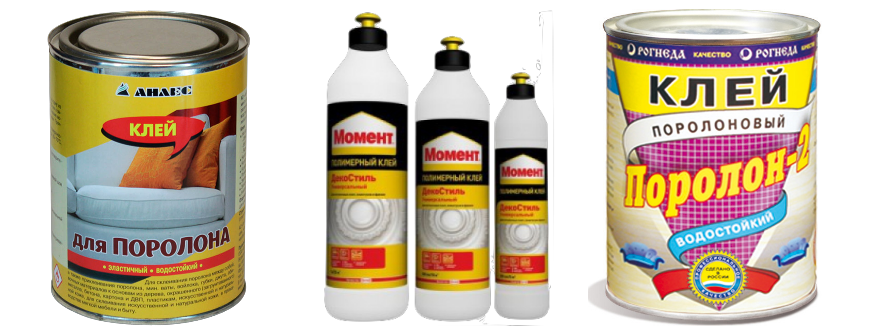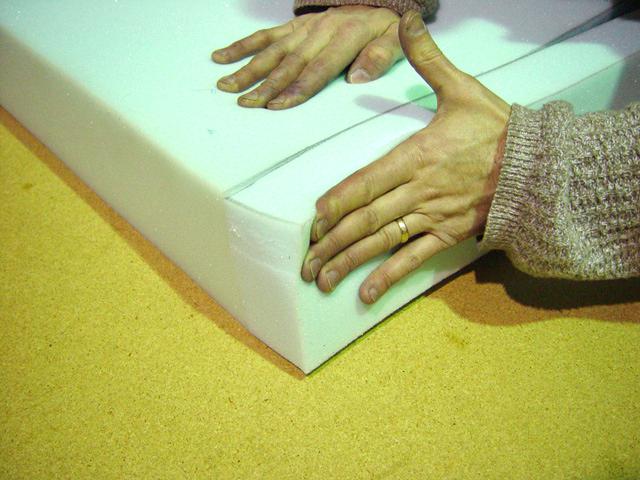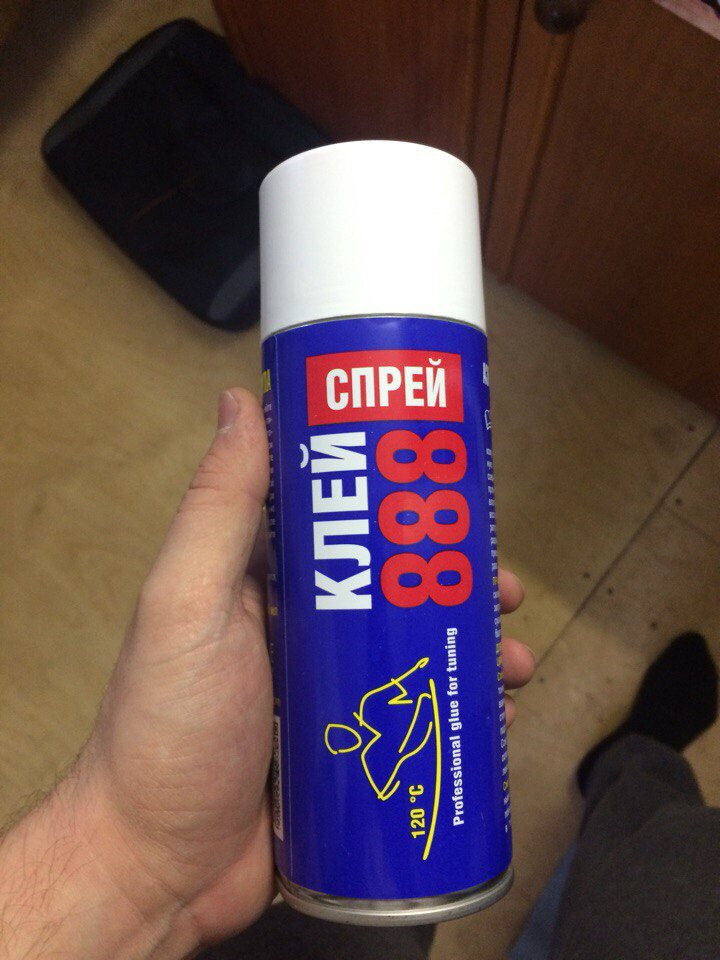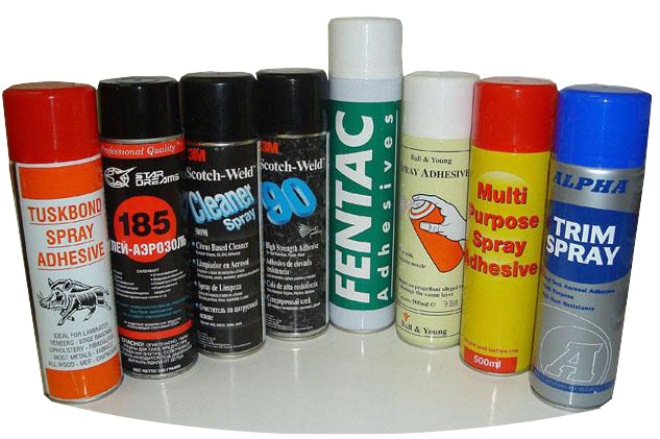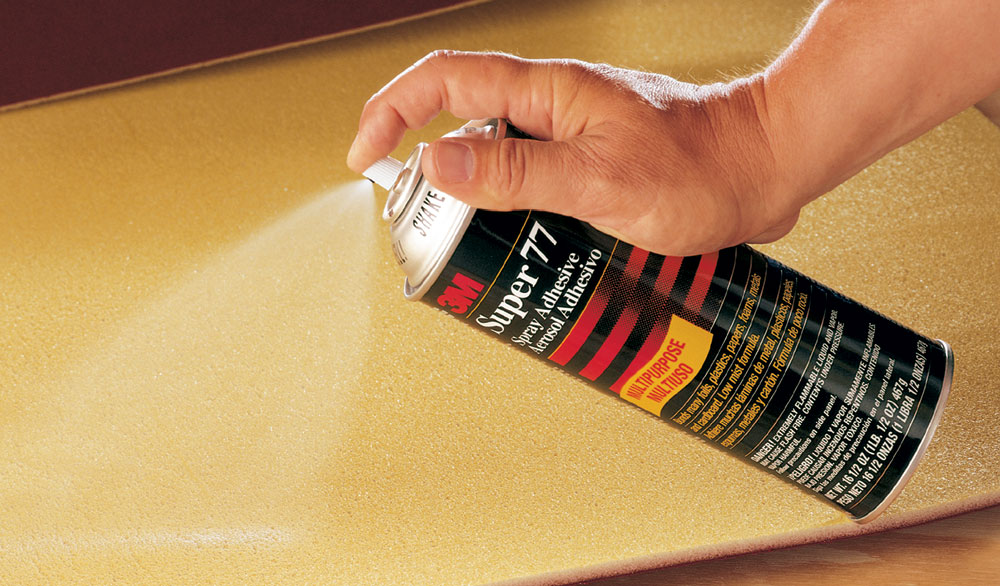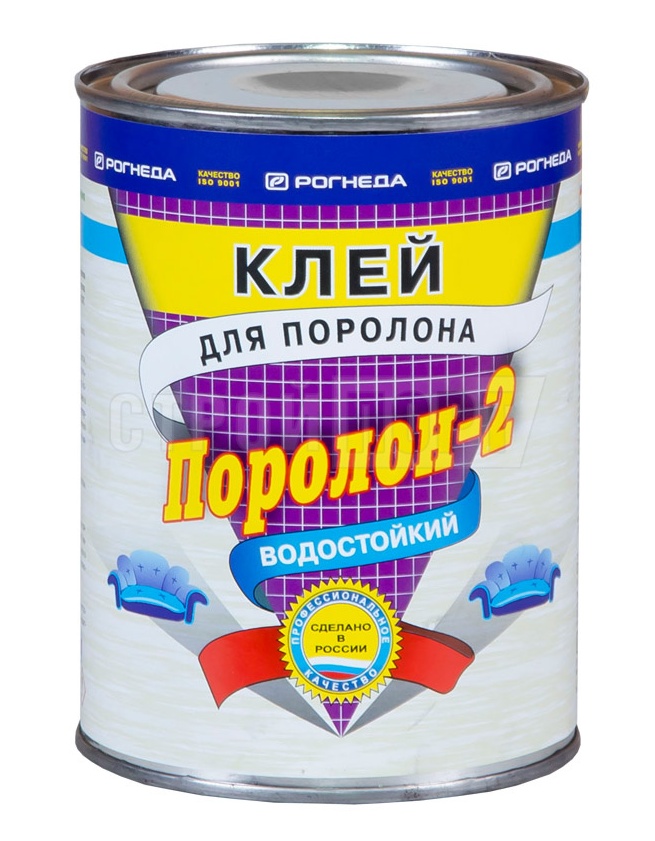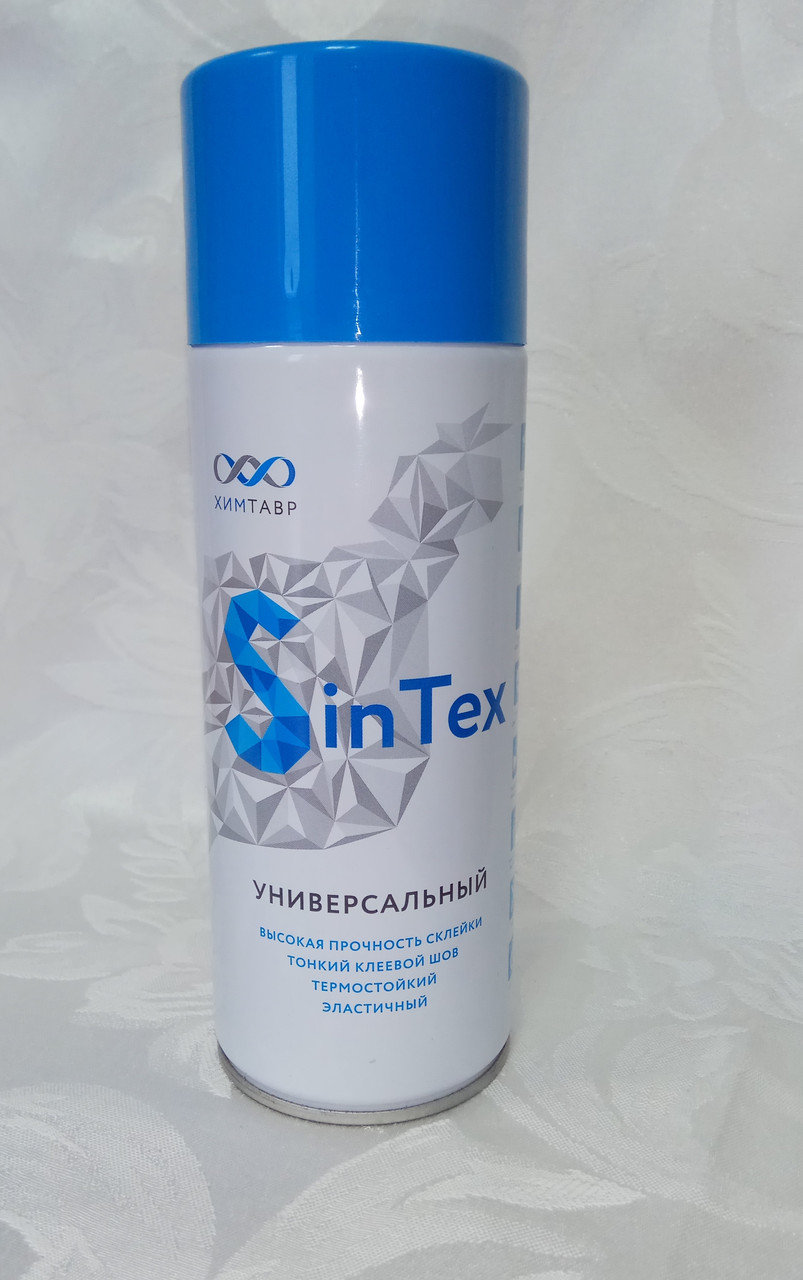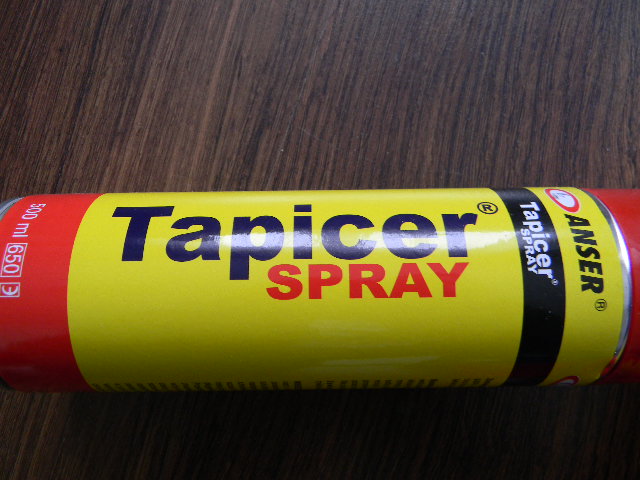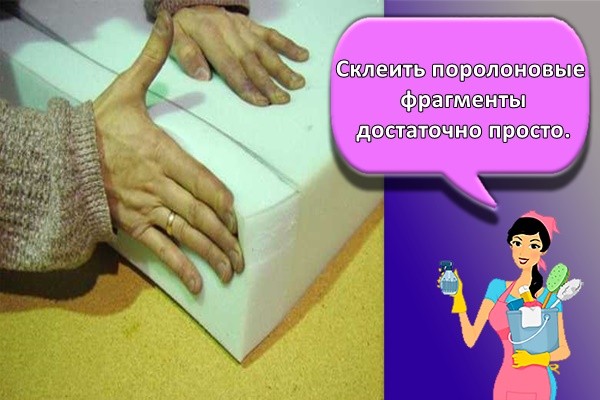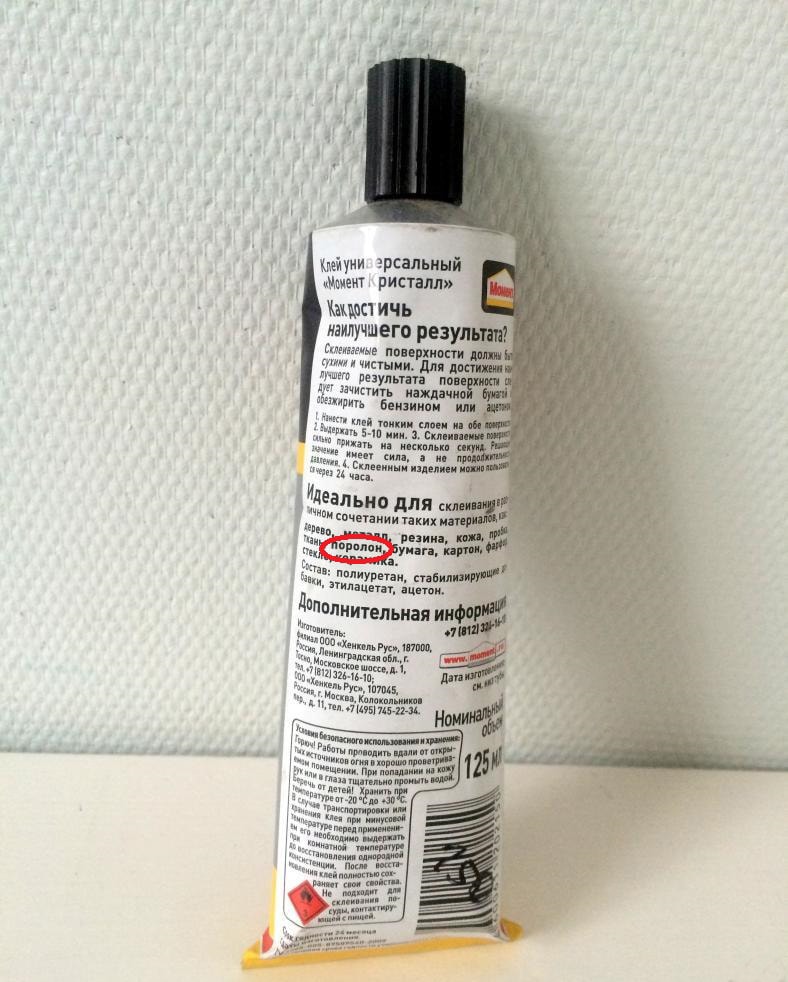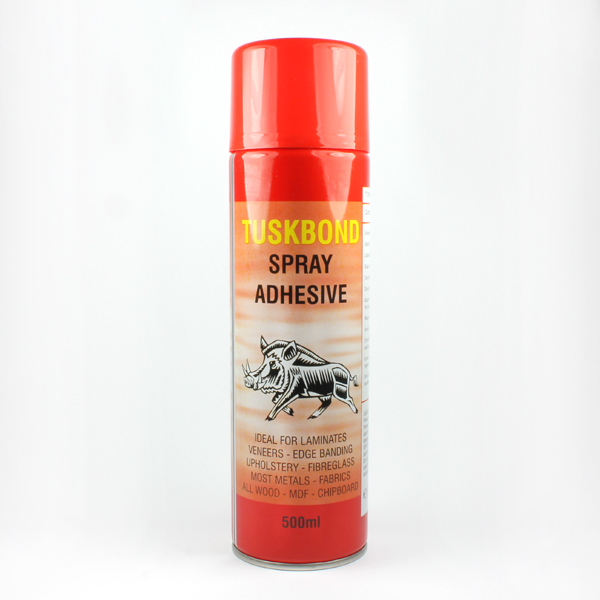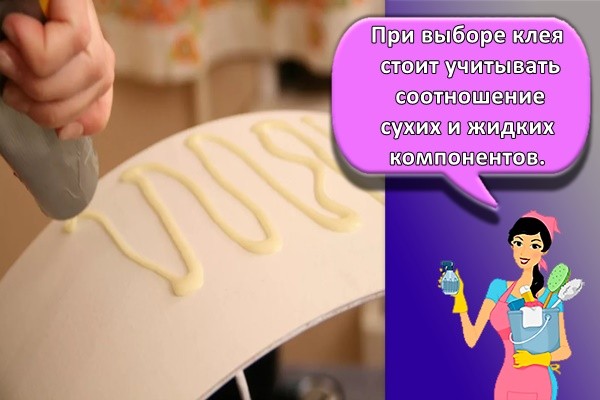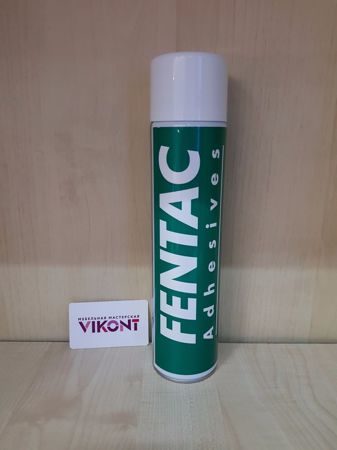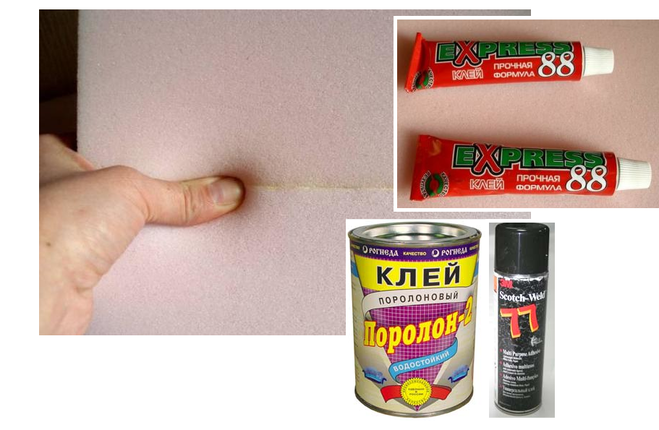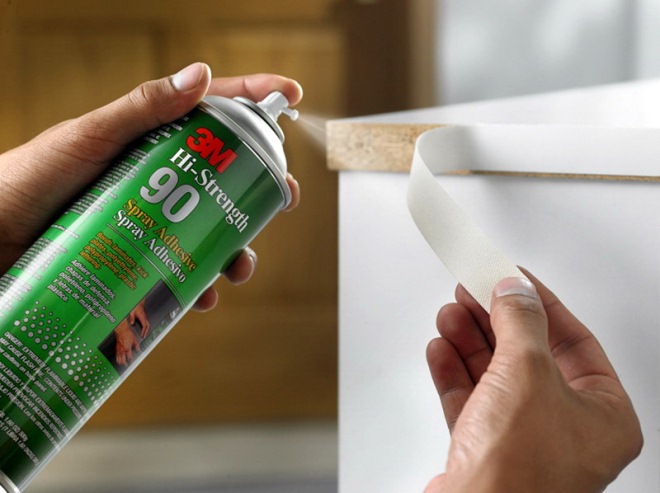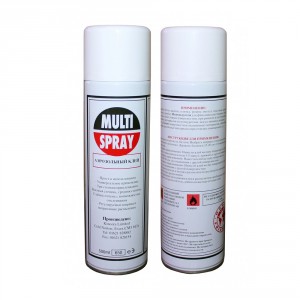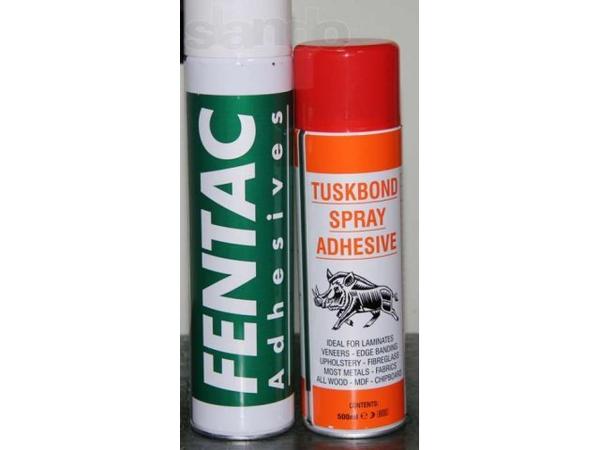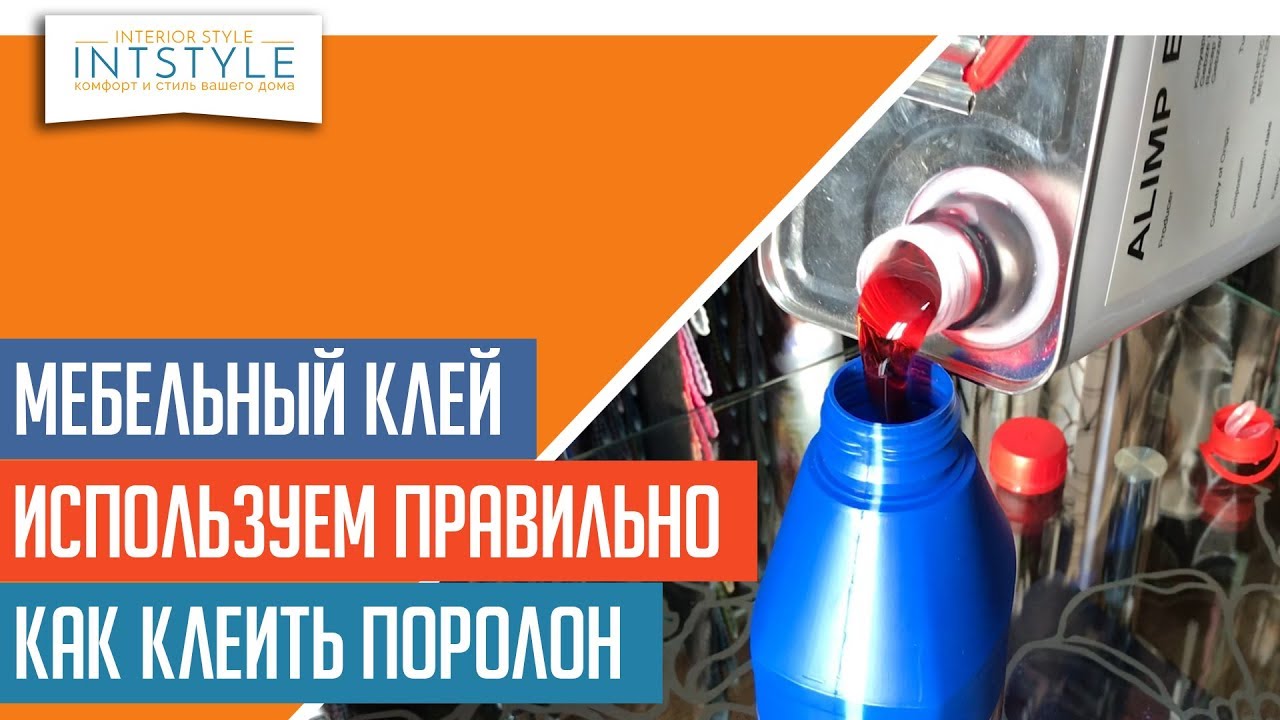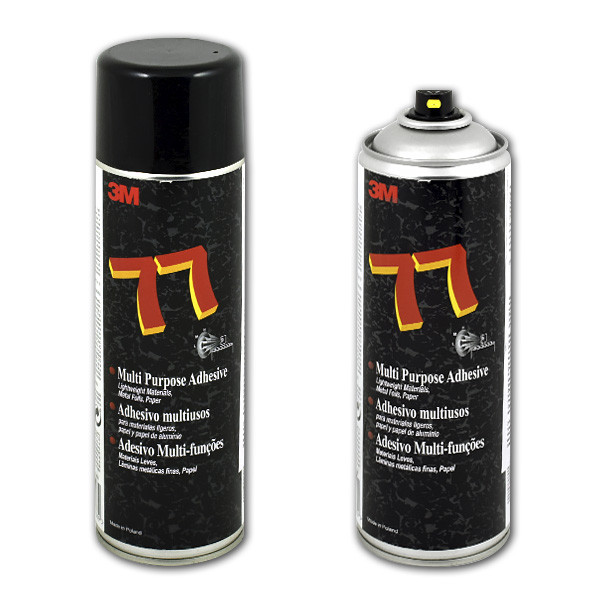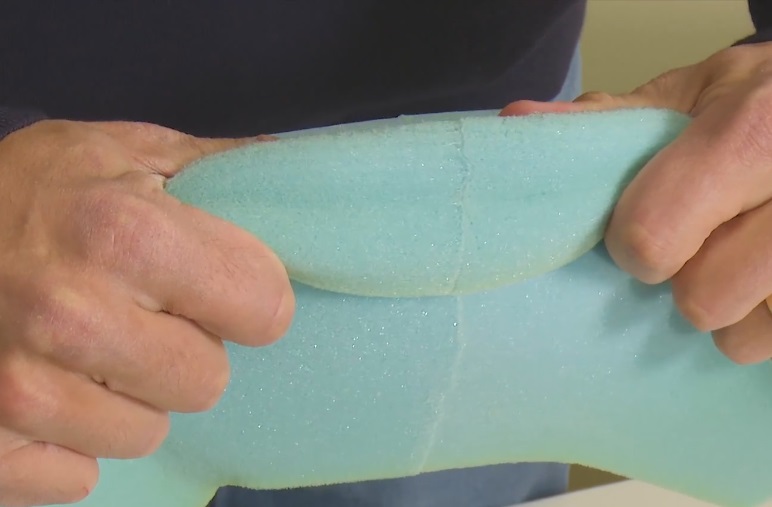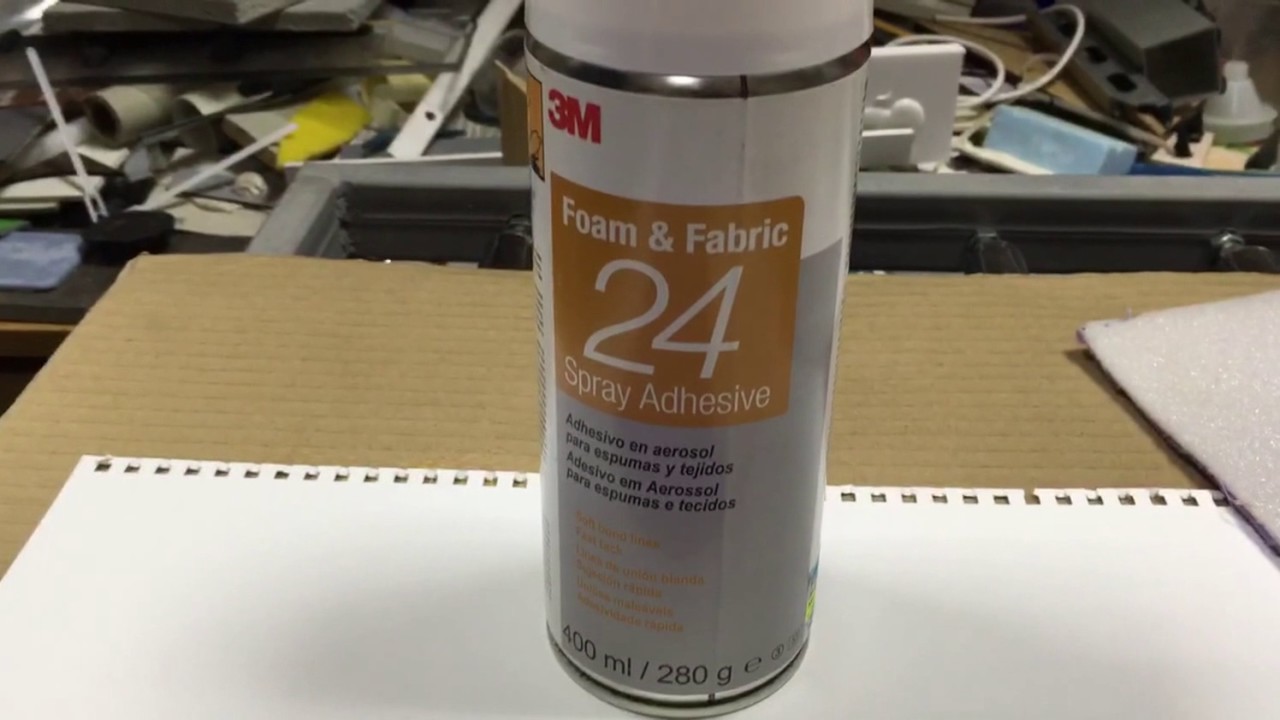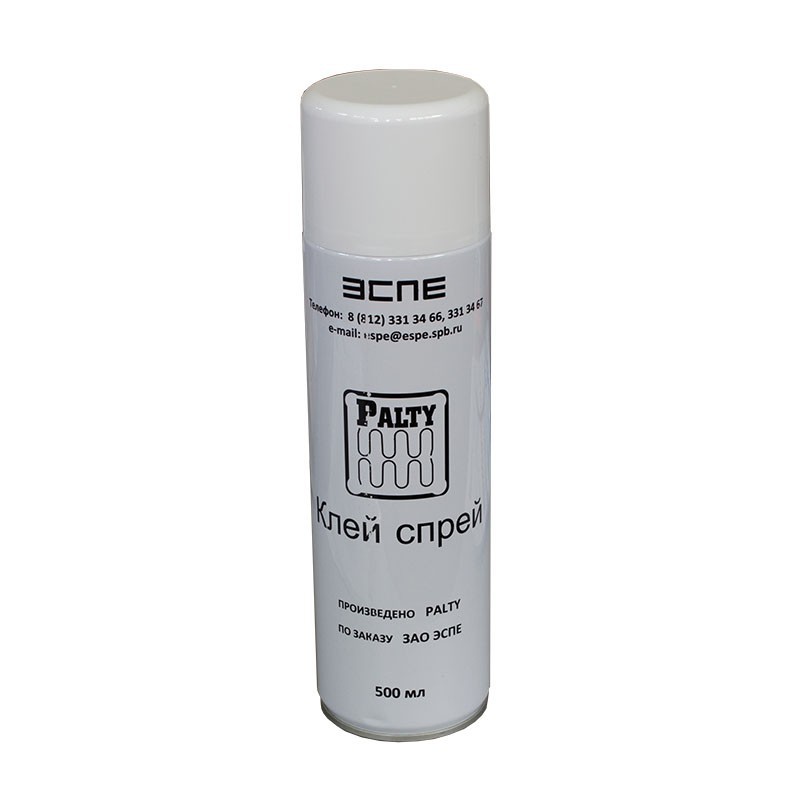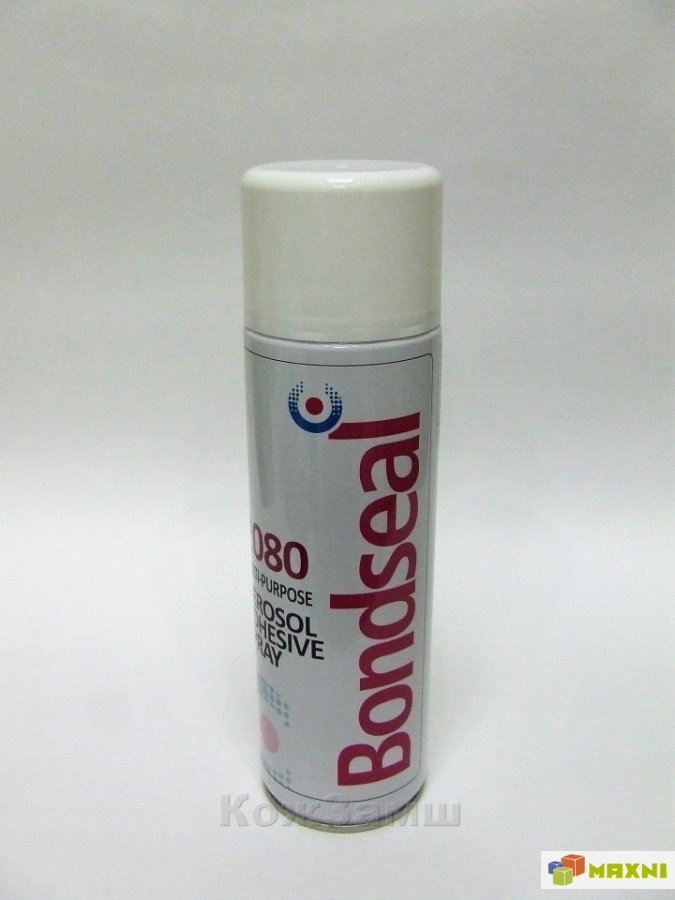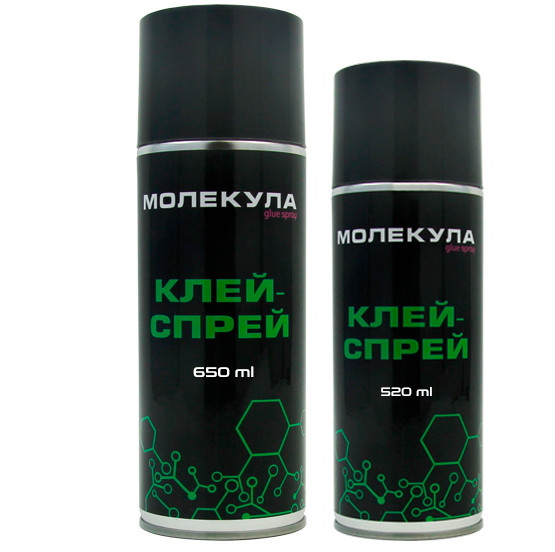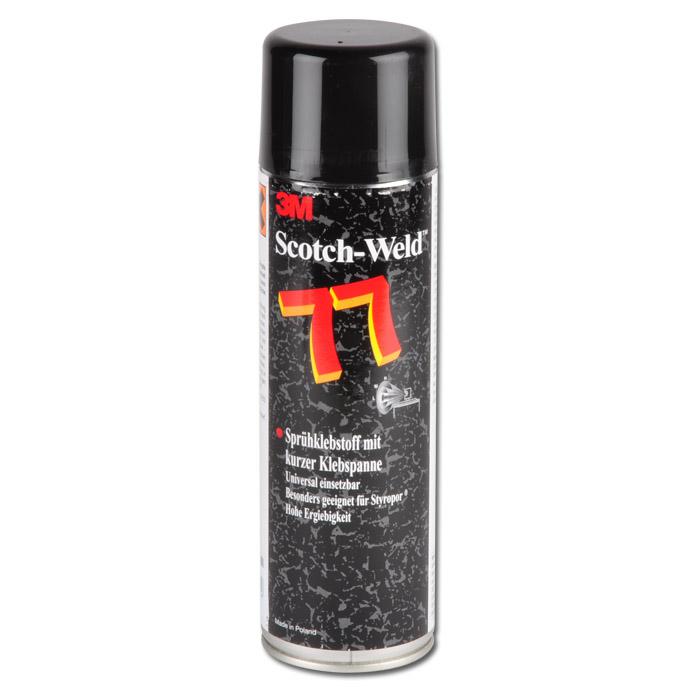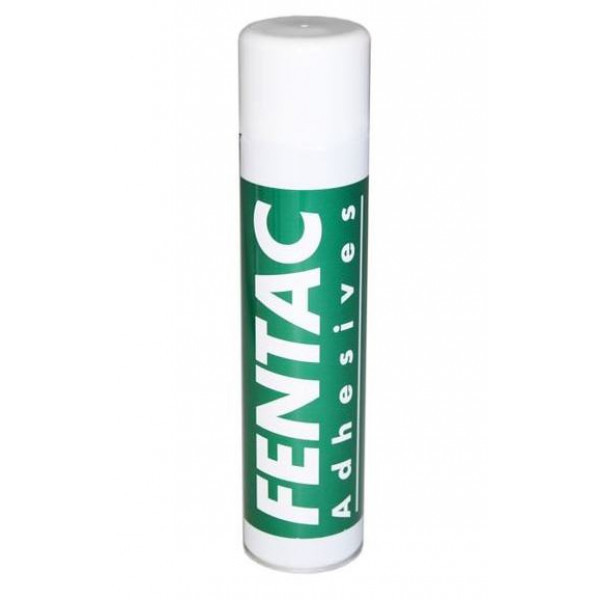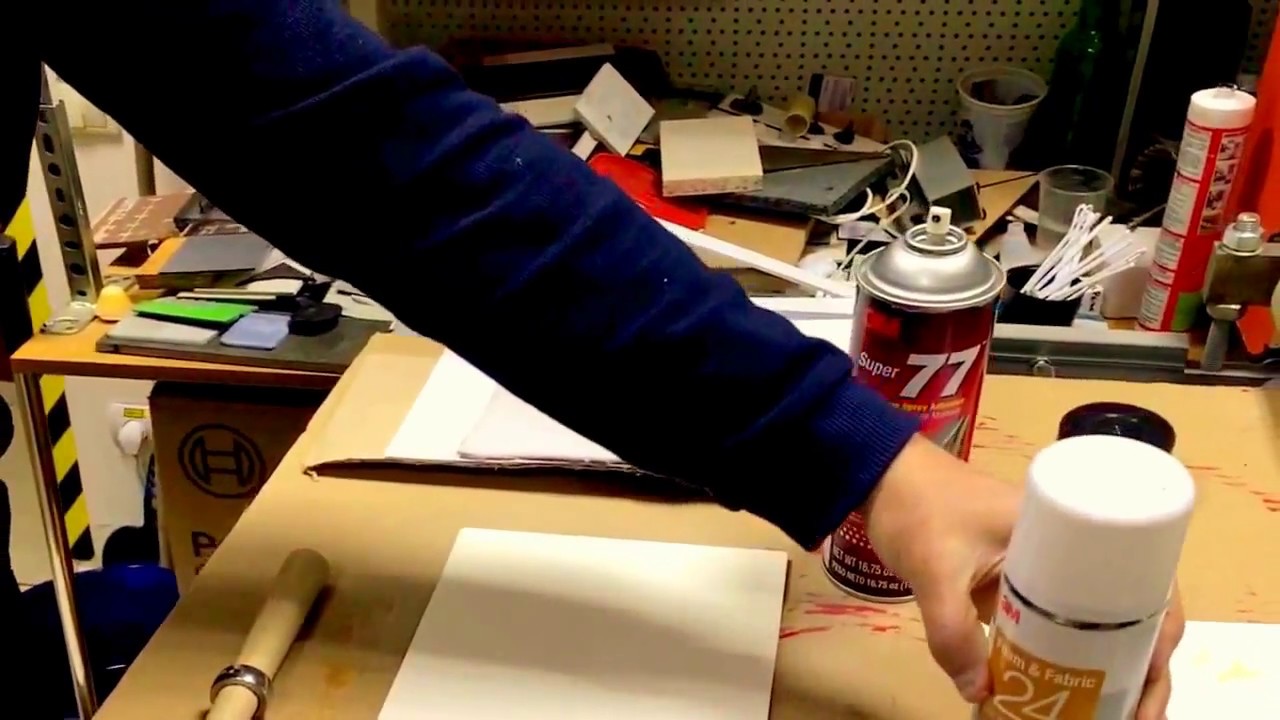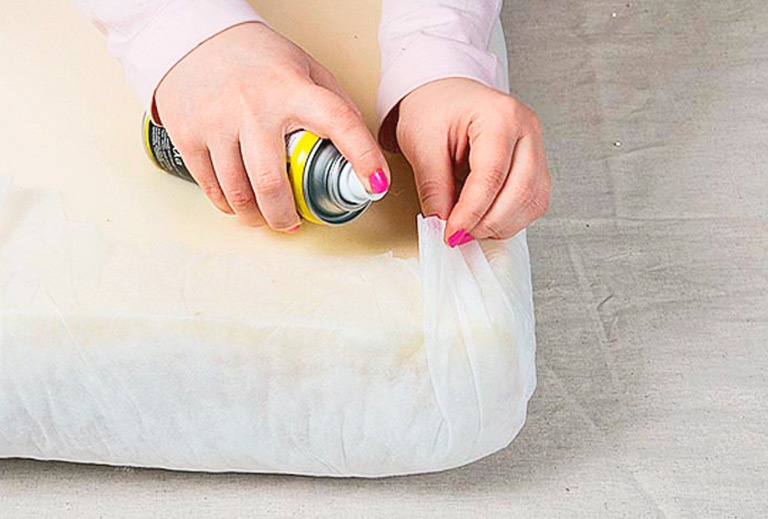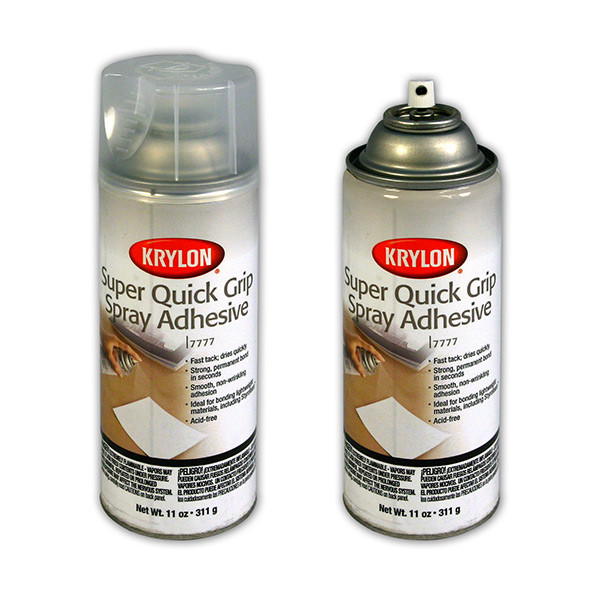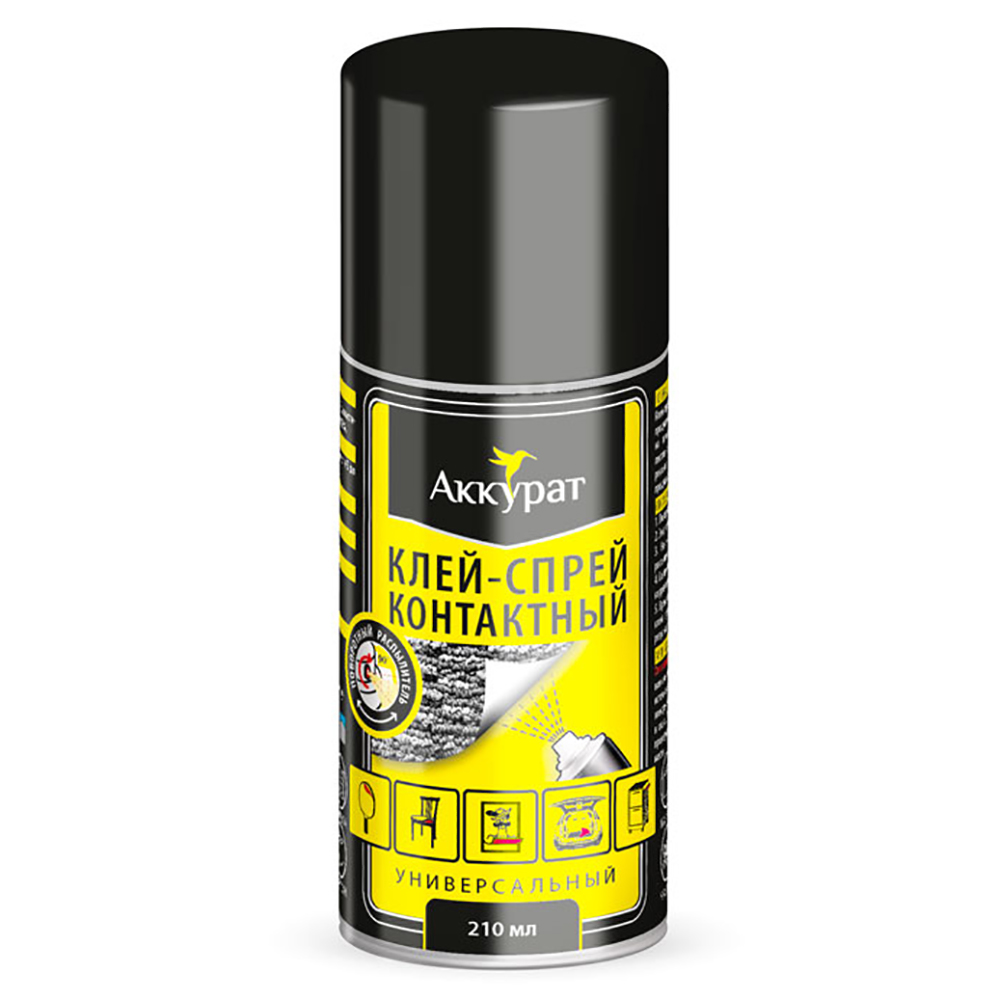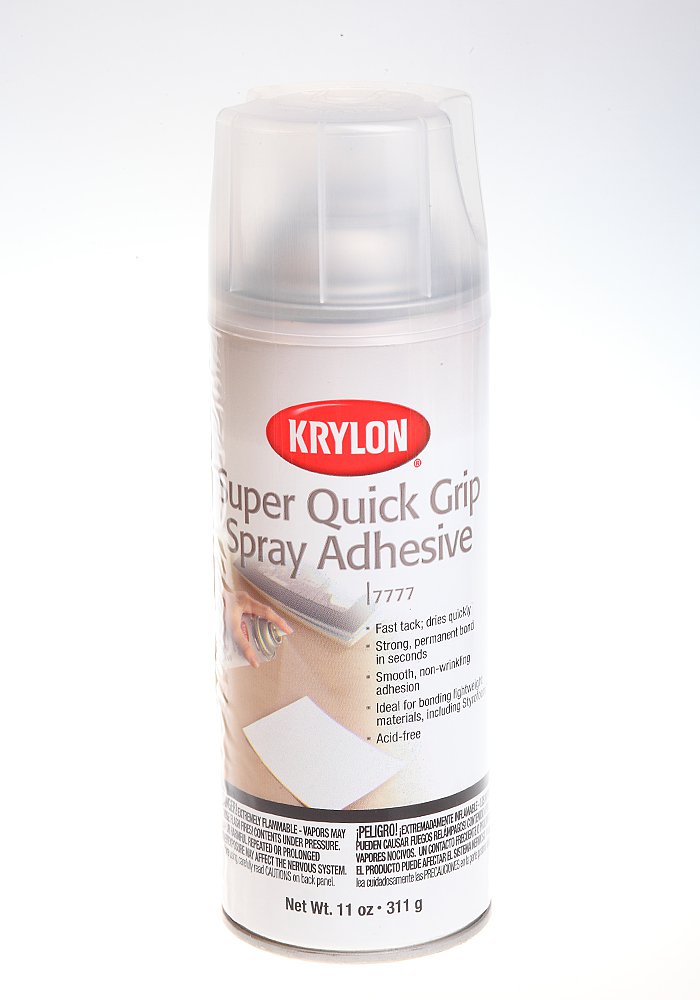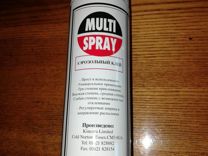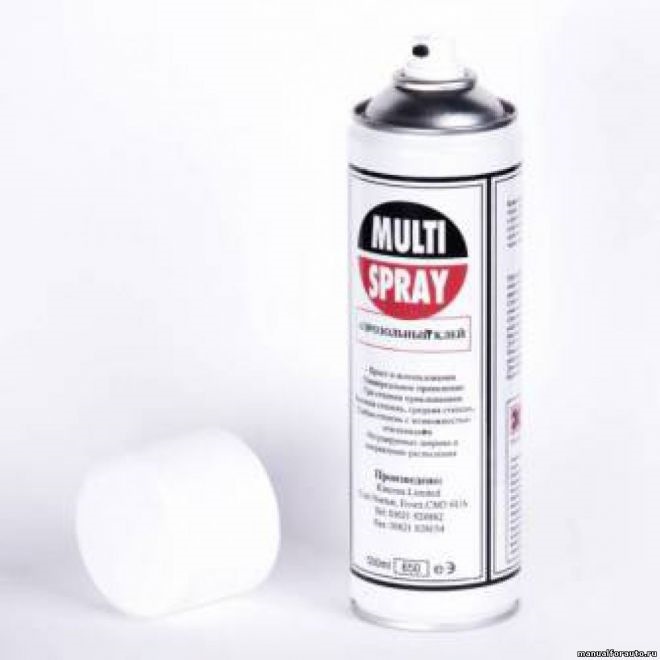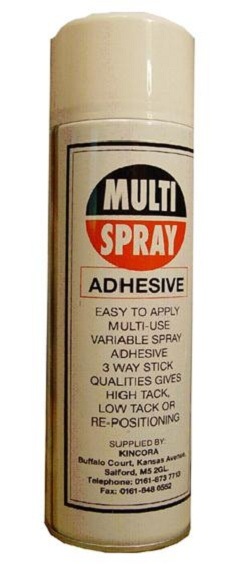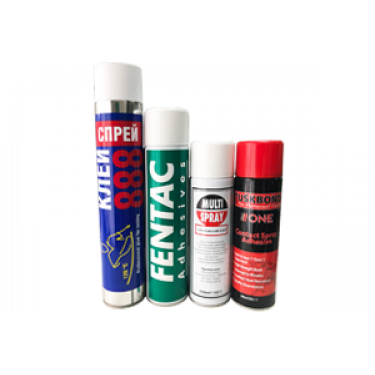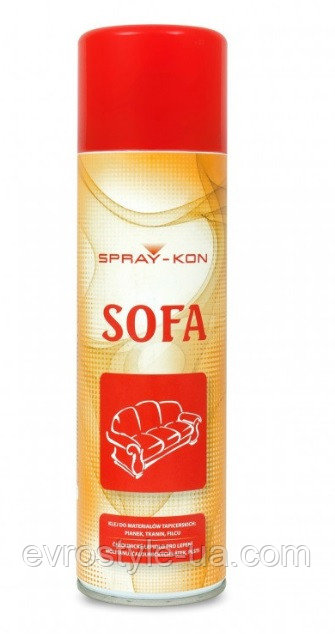1 Choosing a glue for foam rubber - types, features, nuances
The choice of glue is a very important task, on the solution of which the quality of material adhesion depends. Compositions with toluene and trichloroethane are not suitable for gluing foam rubber. These are toxic substances that can have an extremely negative effect on human health and do not provide high-quality adhesion of foam rubber to surfaces.
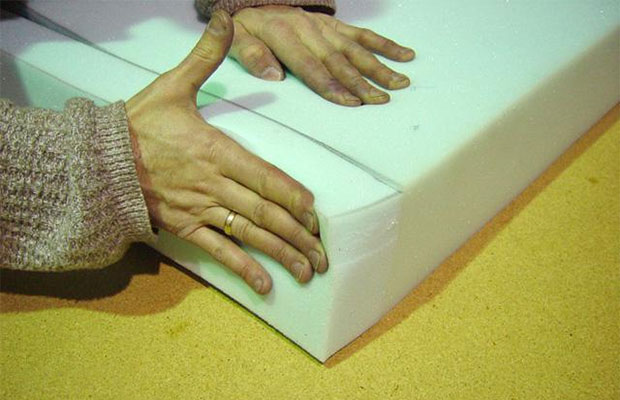
The choice of glue depends on how well the material will adhere
Foam rubber can be glued only with compounds specially designed for this material. On the modern market there is a wide range of substances suitable for such work.
When choosing an adhesive for connecting foam parts with the creation of elastic and durable seams, it is necessary to pay attention to a number of features of adhesives:
- 1. Viscosity. An elastic seam at the point of adhesion of products can be obtained only when using a substance with a viscosity of more than 100 s.
- 2. Dry residue. This parameter describes the ratio of the weight of the dry adhesive film to the weight of the liquid substance. The more dry residue, the faster the glue hardens, that is, the quality of adhesion of products increases and the consumption of material decreases.
- 3. Tint. It is best to choose an adhesive that matches the color of the elements to be glued.
- 4. Setting speed. Curing should begin no later than 2 minutes after applying the composition.
- 5. Type of packaging. The most convenient adhesives to use are those sold in the form of sprays in cylinders. With their help, it is possible to process the most inaccessible places of the materials to be glued with the composition, in addition, they do not clog pores and quickly set.
Taking these features into account, you can choose an adhesive based on neoprene, styrene-butadiene or polyurethane, which will allow the foam rubber to be glued to any surface with minimal difficulty.
How to glue foam rubber at home
- It is necessary to cut off a piece of foam rubber of the required size, which will ensure an even seam when gluing. To increase the adhesion of the surfaces to be glued, they must first be cleaned, removed dust, dirt, and then degreased. For this, you can use white spirit. After, the surfaces need to be dried.
- It is better to glue polyurethane foam at room temperature. An optimum thickening rate is then ensured. Otherwise, the consumption of glue increases, the quality of the seam becomes worse.
- The tools can be brushes, rollers, or the composition can be sprayed from a can. If the glue is in the bottle, the spray distance is correct. It is most economical to apply the glue with a gun, but using a brush can cause overruns of the mixture.
- After carefully applying the composition, the parts must be pressed tightly against each other and wait for the moment the seam is formed. The drying time of the composition may differ, on average it can be 1-60 minutes.
- At home, it is necessary to ventilate the room. Some products contain harmful solvents.
- All work must be carried out away from open sources of fire, since both foam rubber and glue for it are highly flammable and flammable substances. The exception is water-based adhesives. If the material needs to be glued with such a composition, it must be pre-moistened with water.
- If the foam is renewed in upholstered furniture, an additional piece of fabric must be glued over the glue seam. This will provide additional strength to the seam. If a metal or wooden base is pasted over, the compound should be applied to only one hard surface.
Since foam rubber is a very delicate material with a porous structure and filled with air, all actions for pasting it must be carried out very carefully.

Foam rubber is considered one of the most common materials used in a wide variety of activities. The history goes back more than 50 years from the moment when the material was firmly introduced into the everyday life of every family. So, many do not resort to hiring workers for repairs and try to carry out repair work with their own hands. For such purposes, the article examines in detail the topical issue of which glue for foam rubber will be optimal.
The foam material is 100 percent combined with polyurethane, filled with cells with air. Has increased breathability, is not afraid of mold and can cope with temperatures both quite low and high enough. It is for these reasons that the material is so popular in everyday life and at work.

Before starting work, it is necessary to determine how to glue the polyurethane foam together. So, let's look at the main selection criteria and types of glue that are suitable for working with foam rubber
It is important to understand the advantages and disadvantages of a wide range of adhesives in order to make the right choice, as well as study the basic rules for gluing foam surfaces
General requirements for adhesives for foam rubber
In furniture production, foam rubber (flexible polyurethane foam) is a necessary, widely demanded material. Easy to cut, not crumble, cheap. But choosing a good foam glue is not so easy: many adhesives spoil the structure or are quickly absorbed and have a huge consumption.
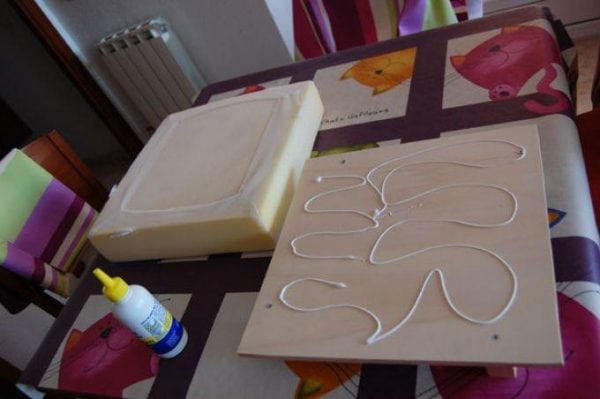
What glue is better to use for gluing foam rubber? The tool must meet the following requirements:
- sufficient viscosity, good elasticity - if the glue is thick, homogeneous, the seam will turn out to be strong, flexible, and with a liquid texture, the glue will flow;
- suitable shade - so that the appearance of the furniture does not suffer, you should select a glue of a shade suitable for the color of the foam;
- soon-drying structure - the glue must set quickly, the process takes no more than a few minutes, but during this period you can manage to move the base if there are flaws;
- one-component composition - high-quality glue is sold ready-made, its components do not need to be mixed together.
After evaluating the composition, it is important to make sure that there is no trichloroethane in the glue - this substance is harmful to humans, spoils the foam rubber. A good product contains rubber, water, solvents, and a number of other targeted additives
You can use materials based on polyurethane, neoprene, styrene-butadiene.
With the help of high-quality glue, foam rubber can be glued not only to wood: the composition is securely attached to plastic, to metal. Most products are suitable for woodworking and shoe repairs.
How to make the right choice
Due to the peculiarities of the composition of the foam rubber, it is not as easy to glue it as it seems at first glance. The material is 90% air, due to the rapid absorption of the glue, it often peels off
To choose a high-quality adhesive composition, you need to pay attention to a number of factors.
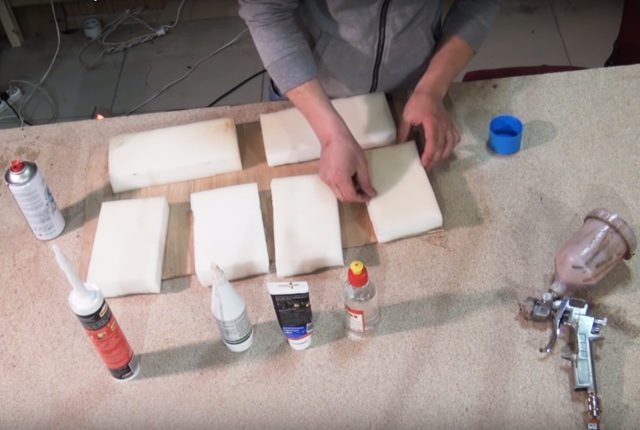
These include:
Read the composition of the foam glue. It must not contain trichloroethane or toluene. They are considered toxic chemicals that make the seam rough. In addition, adhesives containing these substances are hazardous during operation. They give off toxic fumes that are harmful to your health.
You cannot choose compositions with aggressive components that can spoil the material to be glued.
To make the seam inconspicuous, you need to choose adhesives that are similar in color to the parts to be bonded.
When choosing glue, it is necessary to give preference to adhesives, which have a density index of 100s
Accordingly, they are less absorbed into porous surfaces, thereby reducing consumption.
Pay attention to the setting speed of the adhesive mass. The optimal time should not exceed 2 minutes.
Professionals recommend choosing adhesives in spray cans from which a spray spray is sprayed. It is more convenient to apply them on porous foam rubber, and the consumption is reduced.
How can you glue foam rubber
Glue foam rubber can be obtained with different adhesives. There are both special and universal adhesives, which can be divided into two large groups:
- Products for mass use. These are low cost adhesives that can be used to join various materials. Sold in any hardware store.
- Professional formulations. Expensive adhesives that are used in repair shops or enterprises. The high cost and purchase made to order make them less popular with ordinary buyers.
We use for fabric
Aerosol fabric adhesives allow you to bond cotton, felt, coir, textiles, jute and other materials. Due to its transparent composition, it is perfect for repairing clothes, effectively seals tears, punctures.
Used for edging carpets, attaching various details and applications to fabrics.
Properties:
- does not cause deformation of the material,
- resistant to detergents,
- not afraid of high temperatures.
Thanks to the special formula, it does not seep through the fabric, does not roll, it is convenient for fixing the pattern and material, as well as for sewing in zippers. The glue consumption is very economical. Before use, the can should be shaken well and sprayed at a distance of 30 cm.
Multi spray is another great option
Multi spray aerosol glue is produced in England. This unique composition adheres well to different materials - from veneer and metal to foam rubber and cardboard. Acts quickly, glues firmly. It is used for both permanent and temporary fastening of various materials. Suitable for upholstery and finishing work.
To get an effective result:
- the surfaces to be glued must be degreased,
- remove dust and dirt.
- work best with goggles and open windows.
- the balloon must be shaken well and held at a distance of 20 cm.
- apply the glue evenly and leave for 5-10 minutes.
For one surface, the holding time is about 30 minutes, for two - about 2 hours.
You can use solvent to clean the tip on the cylinder.
Safety measures when using glue spray:
- provide good ventilation,
- close the container during work breaks,
- store separately from alkalis and oxidants, away from heating appliances,
- use personal protective equipment,
- wash soiled clothing thoroughly.
For drawing drawings, aerosol glue for stencils is useful, for finishing work - special compounds for working with plastic, paper, plastic.
A large selection of brands and glue will allow you to choose the most optimal option for domestic and professional use.
The author of the article is Kristina Sekushina
How to glue foam rubber: effective brands of adhesives
Consider products from well-known manufacturers. Typically, these compounds can bond other materials with foam rubber, including iron, foam, wood, rubber, etc.
Glue 88
It is a nairite paste that was widely used in the 90s. last century.
The basis of the mixture is rubber. It is ready-to-use and does not need to be mixed with other ingredients. To glue the foam rubber to wood, plywood, chipboard, that is, to any wooden surface, it is enough to apply a thin layer of glue 88. You will get a seam resistant to low temperatures.
Foam rubber 2
Foam rubber-2 glue is actively used in the furniture industry and in manufacturing. They can glue foam rubber to metal, wood, chipboard, fiberboard, cardboard, drywall, fabrics, leather, rubber, and other surfaces.
Before gluing, the surfaces must be cleaned, degreased and dried.These measures will increase the adhesion properties of the materials to be glued, and make the seam strong and durable.
Rapid 1000
There is no solvent in the composition. It is a non-flammable substance with a pungent odor that evaporates after 6 minutes. after application. The seam will be firm and even. The product is quick-drying. Acoustic foam can be glued.
You can glue the foam together. BF-6 is easy to use, safe and odorless. Before work, it is necessary to pre-moisten the surface to be treated. The composition is applied in 2 layers. The first layer should be thin. The second is applied only after the first is completely dry. When the mixture is completely dry, the seam must be gently ironed with an iron through a damp cloth.
Saba comes in aerosol form and is sprayed with a gun. Bonding increases the adhesion of the treated surfaces. The product is non-flammable, safe, resistant to high temperatures. It is used in production and at home.
Olimpur
Water based mixture. On the surface, it must be applied pointwise. Olimpur is used to glue the material to plywood, polystyrene, plaster, drywall, fabrics, and other building and finishing materials. You need to apply the composition pointwise to a previously prepared surface.
Sintex
Sintex glue is available in the form of cans, tubes, but it is most convenient to use an aerosol in a can. The basis is rubber. The non-flammable product is used in the manufacture of mattresses and furniture. When gluing with Sintex, a thin, durable and very elastic seam is formed.
Fentac Fensol 60 Adhesive
Available in aerosol form. The composition is based on synthetic rubber and a hydrocarbon solvent. It is best glued to plastic, although other materials can be glued as well.
The tool is consumed sparingly.
Glue spray Palty
Palty aerosol adhesive based on synthetic rubber. It is moisture resistant and highly durable. Suitable for upholstered furniture with a foam rubber layer. They are glued to the driver's seats in cars.
TAPICER
It is sold in a metal aerosol can, therefore it is applied only by spraying. The basis of the paste is BS rubber. The tool is used for upholstered furniture made of foam rubber, for gluing felt, fabric, for attaching polyurethane foam to metal, concrete or wood.
Sefox
This is furniture glue. The product is specially designed for the furniture industry and the production of mattresses. You can glue the foam layers together, glue them to wood, felt, fabric, metal or plastic. It is a non-flammable mixture, the use of which significantly reduces the likelihood of fires. Apply the composition with a pneumatic gun at a pressure of 3-6 bar on one of the surfaces to be glued. The thick consistency significantly reduces the consumption of the adhesive, saves about 40% of the mixture.
AOS-TAP
Glue AOS TAP or TAPITSA is intended for gluing upholstered furniture. It is used in car seat upholstery, for fixing foam rubber to fabric, leather, wood and other surfaces. The composition is not suitable for connecting foam rubber and plastic, doors, torpedoes. The basis is SBS rubber. Additional ingredients: solvent, reactive resins. Can be applied by brush or spray. Drying time for one layer is 5-7 minutes. Final adhesion occurs after 12 hours.
Sold in cans of 1 kg, in cans of 8.5 kg or in eurodracks of 15 kg.
How to use universal glue in an aerosol can:
- the surface for gluing must be dried, degreased, cleaned from dirt,
- work is carried out in a room with room temperature,
- shake well before use,
- if the objects are light, it is enough to apply glue on one side, if the surface is porous, then on both,
- it is necessary to stand until completely dry within 30 minutes,
- for the densest adhesion, the glue is applied in two layers with an interval of five minutes,
- you need to store the composition at a temperature of +5 to +30 degrees.
OUR CHOICE
Aerosol glue 3m is one of the most popular formulations today. It is ideal for surface treatment and installation, leaves no residue and can be used to re-glue even complex materials repeatedly. The glue jet is controlled at the touch of a finger, while the other hand remains free. Does not require the use of jars, brushes and other additional tools.
Another popular composition is Abro aerosol glue, which glues surfaces in a few minutes. Does not lose its properties at temperatures from -23 to +93 degrees. Easy to apply to hard-to-reach places, firmly bonds plastics, wood, laminate, polypropylene, polyethylene and light metals. The kit includes a nozzle for even application, and the sprayer operates in three modes - minimum, medium and maximum.
Aerosol adhesive technology
The quality of the connection depends on the correct choice of adhesive spray and the method of its application. Detailed instructions can be found on the back of the bottle. However, getting acquainted with the recommendations of the professionals will be useful for any beginner.

The technology consists of several stages that must go one after another:
- Prepare the surface for work. Clean the glued sides from dirt, dust. Wipe with a degreasing agent, wait until the materials are completely dry.
- Shake the can several times. Apply the adhesive mass by lightly pressing on the cap. If the whole product is heavy, cover both surfaces to be glued with glue, if it is light - one.
- The distance between the balloon and the material during application should be about 20 cm.
- After covering with the first coat, wait 10 minutes, apply the second.
Apply and wait 30 minutes until the adhesive dries.
Safety and work tips
To make a high-quality seam and not harm your body in this process, you must remember about safety precautions:
- The room in which the work is carried out must have good ventilation.
- Work with gloves and overalls.
- Wash off the adhesive from the skin with soap.
- Do not work near open flame sources.
- After use, do not forget to close the bottle with a cap.
Check the expiration date before starting work. Do not use a damaged (crumpled) balloon.
Storage
It is necessary to store the aerosol contact adhesive in a dark place, at a temperature of 5-30 degrees Celsius above 0. The storage place should be away from children, heating devices and direct sunlight.
Alternative glue for foam rubber
In addition to special adhesives that can be found in hardware stores, craftsmen in repair shops recommend using analogues.
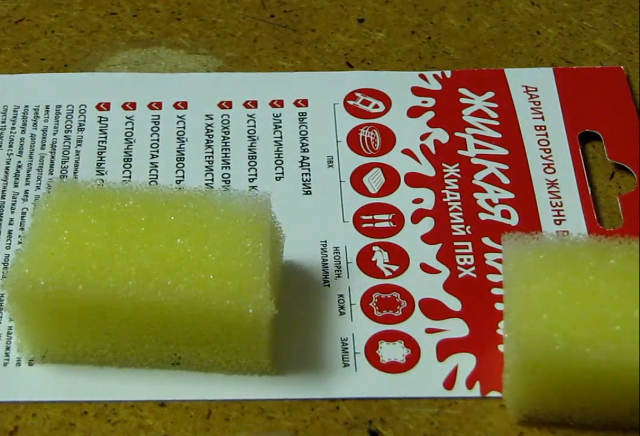
These include:
- Titanium Wild - a special composition for repairing upholstered furniture, stickers of polystyrene tiles on the ceiling. The main disadvantages of this glue are that the seams on the foam rubber will be felt, it dries much longer than the brands presented above.
- Crystal Moment. The packaging indicates that it is suitable for bonding porous materials. However, it is considered not the best option. According to numerous customer reviews, docked parts quickly unstick, and the strength of the joints is lost.
- Silicone sealant. It is considered a good substitute for special adhesives. Allows you to stick foam plates to different materials. The main disadvantage is the long drying time (at least a day). It is difficult to clean it from stained surfaces.
- Hot glue - suitable for bonding foam rubber. However, due to the rapid solidification, work must be carried out quickly. Hot-melt foam rubber has tangible seams, which is why it is considered less popular.
Some masters advise to temporarily glue porous materials with double-sided tape. However, it is not suitable for this purpose.
The best universal adhesive from analogues
We first looked at the various specialized brands.Now we can say which glue is better for foam rubber analogs. Any suitable formulation is considered relevant for a specific purpose.
According to buyers, you can make a small rating from best to worst:
- Crystal Moment.
- Silicone sealant.
- Hot melt glue (for quick gluing).
- Adhesive composition Titanium.
- Universal PVA.
This rating can be guided only approximately.
What varieties and brands are suitable
There are many types of glue that can be used to glue foam rubber. This allows you to choose the best option.
88 n2
It is a popular substance that is often used by hobbyists and shoe repairmen. It is also often used in enterprises. This glue is packaged in metal containers. They can have different volumes. It is recommended to apply the composition with a roller or brush.
88 n
This glue has been popular for a long time. It is often called a shoe. The substance is made on the basis of rubber. It can be used to fix different materials. As a result, it is possible to obtain a durable seam that is resistant to low temperatures. The disadvantages include an unpleasant aroma and a long bonding time.
Sintex
Sintex glue is produced in the form of tubes or cans. However, the most convenient option is considered to be a substance in a balloon. Sintex MF glue is based on rubber. The substance is used in the manufacture of furniture and mattresses. When using foam glue, it is possible to obtain a strong and elastic seam.
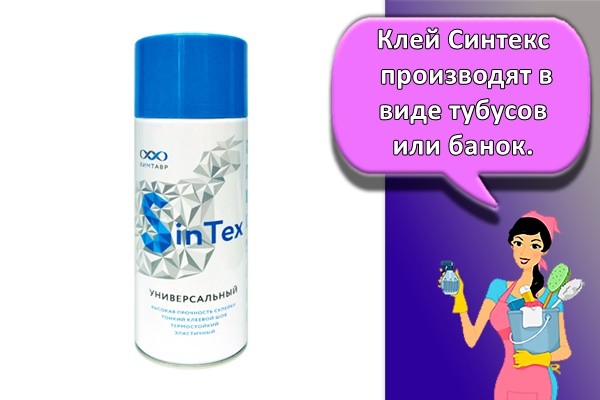
Sefox
This is a furniture glue that allows you to glue foam rubber or fix it on plastic, textiles, wood and other materials. It is a non-flammable compound that minimizes the risk of fires. The glue is characterized by a thick consistency, which makes it more economical.
Saba
The product is produced in the form of an aerosol and sprayed with a pistol. Bonding increases the adhesion of the treated surfaces. The composition is considered non-combustible. It is completely harmless and resistant to high temperatures.
BF 6
The tool is used for gluing fragments of foam rubber. The substance is easy to use. It is safe to use and odorless. Moisten the surface before work. It is recommended to apply the substance in 2 layers. The first is made thin, the second is applied only after the substance has completely dried.
Olimpur
The composition is water-based. It is recommended to apply it in a dotted manner. The substance is used to fix foam rubber elements. Also, the composition allows you to stick foam rubber to foam, plywood and other surfaces.
Rapid 100
The product does not contain solvents. It is considered non-flammable and helps to obtain a strong and even seam. The composition dries quickly and is often used to fix acoustic foam rubber.
Tapicer
The composition is packaged in aerosol metal cans. Therefore, it is applied by spraying. The tool is made on the basis of rubber and allows you to glue foam rubber fragments or fix them on other materials.

AOC TAP R-01
The product is suitable for gluing upholstered furniture. The composition is not able to combine foam rubber with wood or plastic. The basis of the substance is SBS rubber. It also contains reactive resins and a solvent.
Universal PVA
It is a versatile substance. To glue the foam rubber to an uneven surface, it is first fixed with tape. It takes at least 24 hours for the glue to dry. The result is a tight seam.
Foam rubber-2
The adhesive is used in the furniture industry. It helps to fix the foam rubber on metal, wood and other materials. Beforehand, the surface should be cleaned, degreased and dried.
Titan Wild
The product is produced in containers with a volume of 0.5 liters. It takes a day to dry the composition. The result is a tight and tight seam.
Crystal Moment
This product is produced in vials with a capacity of 0.125 liters. The composition helps to glue different materials.The substance is easy to apply and fixes foam fragments well.
Silicone sealant
The composition is produced in tubes. It takes a day to dry. The result is a soft seam. It adheres well to foam rubber and materials that have different rigidity.
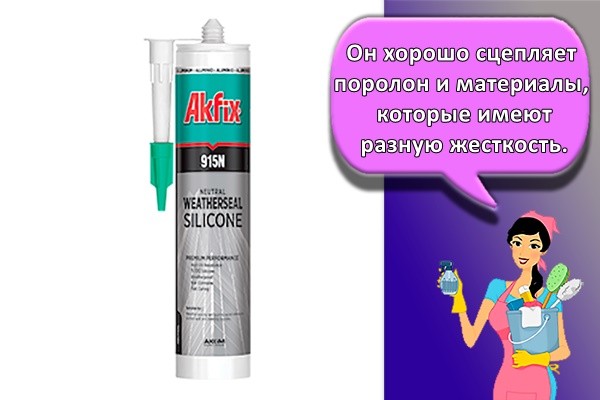
Hot glue
The product is produced in the form of cylindrical sticks of different sizes. The composition fixes foam rubber well. However, the seam after drying is very hard and tight. The substance dries quickly and loses its characteristics. Therefore, it is not used for fixing large surfaces.
Double sided tape
This tool does not allow you to glue fragments of foam rubber. It has poor adhesion characteristics to any surfaces. Therefore, scotch tape is not used to solve serious problems.
How to glue acoustic foam rubber
There are several types of adhesives for acoustic foam rubber. Each of them has its own characteristics during the work.
One-component acrylic-based compounds - installation process:
- Prepare the area for the sticker. Clean it from debris, dust.
- Apply the adhesive mass to the acoustic boards with a spatula, spreading evenly over the entire surface.
- Press them against the wall.
It is enough to hold the panels under pressure for 1 minute so that they firmly adhere to the wall.
Liquid nails - step by step instructions for use:
- Clean the work surface from all kinds of dirt and dust.
- Using a nail gun, apply thin strips of liquid nails to the wall.
Using hot melt glue:
- Load the gun with a glue stick.
- Wait 15 minutes for the gun to heat up.
- Wipe the work surfaces with a napkin.
- Outline the base for the slabs. Clean it from dirt, dust.
- Apply the adhesive quickly to the prepared substrate.
Press the acoustic boards against the wall, wait 1 minute.
Output
It should be noted that now large and well-known manufacturers are not standing still, they are improving their assortment. Here is just a small list of adhesives for foam rubber. In fact, there are much more of them, because new specialized formulations for this particular material are not uncommon in the construction market today. All that remains is to test them, so the choice is yours.
Foam rubber is considered a fairly popular material in different areas of the industry. To connect it to each other, or to other surfaces, you need to carefully select and use glue.
Release form and brands advised by professionals
When choosing any brand of retainer, look at the consumption rate, shelf life.
Rapid 100 - there is no solvent in its composition, non-flammable, the curing time is several seconds, it forms an even strong seam.
Glue 88 for foam rubber is universal - based on synthetic rubber, resembles shoe glue in structure, suitable for application over large areas, drying time is about a minute, without color. A thin layer is enough for fast and strong fixation of materials. Equally quickly grasps any surface with foam rubber. Must be cleaned of dirt before application. Leaves an even, soft seam.
Saba - Available in aerosol cans and cans. Suitable for various surfaces in terms of area and composition, frost-resistant, long drying time. Has no harmful impurities, wide temperature range, provides high-quality adhesion.
Moment for foam rubber - has no color and odor, the stated drying time is 10-15 minutes, adheres well to surfaces, but expensive.
PVA liquid - dries for a long time, glued surfaces require additional fixation. The seam is soft.
Hot glue - dries very quickly, glues any surfaces, but gives a hard, hard seam.
Double-sided tape - does not hold.
What is aerosol adhesive - description
Glue in a can or aerosol glue is a universal fixing agent, suitable for bonding homogeneous and different-textured materials.A special feature is the form of release - it is sold in spray bottles, representing a glue-spray. Thanks to this, it has the following advantages:
- easy way to use;
- creating a thin, even layer;
- the ability to adjust the thickness of the seam;
- application over large areas, in hard-to-reach places, if required;
- no need to buy rollers, spatulas;
- economical consumption;
- long shelf life (due to the tightness of the package);
- transparency of the composition, the possibility of using it even on colored products;
- no stains, smudges, streaks after drying;
- the ability to replace double-sided tape.
The composition of the glue in the aerosol does not differ from its analogues, the only difference is that it does not need to be squeezed out, poured from tubes, bottles. Despite the higher cost, such tools are very popular, because even in the most remote corners of parts, they create reliable, strong connections. Most aerosol adhesives have a high level of adhesion to various surfaces and are characterized by fast setting times. As they dry, they do not lead to warping of fabric and other thin materials, and are practically invisible on the items.
How to use foam glue
It is advisable to first familiarize yourself with the manufacturer's instructions. The technology for gluing foam rubber on glue of different bases is slightly different.
- For fixing to a dense, rigid base - one-sided application of glue to the base.
- For gluing foam surfaces to each other - double-sided application of glue.
Observe the temperature regime, from 15 ° C in the room, if the temperature is lower, then the composition becomes thicker and the consumption of glue increases.
Professionals advise using a spray gun instead of a brush to apply the adhesive, but if it is not there, then you can take a plastic bottle, make a thin hole in the cork, apply the composition on the surface with even random layers through the hole.
Basic moments:
- Do not allow the adhesive mass to come into contact with open skin areas of the body and eyes.
- Do not work near fire.
- The room should be well ventilated or work in a respirator, as glue with the addition of solvent smells harshly.
Popular temporary adhesives
The adhesives can be supplied in spray, aerosol and pad form. The spray is ideal for leather, velvet, knitwear, it provides temporary fixation of patterns and stencils. A workpiece with such glue can be re-glued several times.
If the product will be machine-stitched, it is important that the glue does not clog the needle hole, otherwise the needle may deteriorate.
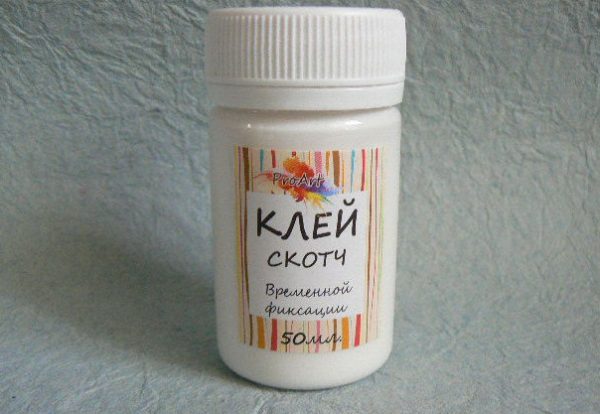
It is more convenient to use aerosol adhesives when working with stencils and blanks made of cardboard, glass, paper, wood. The products are quickly distributed over the surface, without forming lumps, and the layer is very thin. Temporary adhesives in pillows are usually used to decorate premises for holidays, special occasions, and they can also be used to fix patterns, calendars, posters, garlands for a short time. More expensive pads are used many times, since they do not lose their adhesive properties for a long time.
Also, temporary adhesives are divided into special and universal. The first ones are intended for fastening only one group of materials - textiles, wood and cellulose derivatives, glass, etc. The universal ones are suitable for any surfaces and can be applied in the following ways:
- fixation until the moment the product is washed;
- one-sided fastening with the possibility of correction;
- double-sided fastening for a longer period.
The most popular brands of temporary adhesives are:
- 3M Scotch Weld. The aerosol is suitable for bonding dissimilar and homogeneous materials, allows for multiple bonding. Great for labels, silk-screen printing, does not warp paper, does not harden over time.
- Marabu-Fix it. Colorless spray for cardboard, wood, paper and plastic.It is also used to secure fabrics when decorating.
- Prim. Provides temporary fixation of textiles, removes the need for pins. Washes off without residue with plain water.

- Idea Decoupage. Made in Italy, high quality. Helps to repeatedly glue and remove film, fabric and cardboard images, stencils. It is widely used in design.
- KK. Transparent non-toxic glue, used for attaching non-glue interlining, small parts that are difficult to attach with a hoop when embroidering. Suitable for knitwear and stretch fabrics.
- UHU Tac Patafix PROPower, heavy-duty temporary attachment pads. They are capable of holding objects weighing up to 3 kg, suitable for internal and external surfaces. Resistant to moisture, not affected by UV rays. Can be used multiple times.
Safety and recommendations
Compliance with safety measures when working with glue, as well as with other chemical compounds, is mandatory:
- work only in a ventilated area;
- protect hands with gloves, work in overalls;
- do not smoke during work, exclude other possibilities of contact with fire, otherwise the product may explode;
- in case of contact with skin, wash it immediately with soap;
- wash clothes soiled with glue immediately;
- do not put glue next to alkalis, acids, near the battery - it may deteriorate;
- close the glue cap tightly outside of its use.
Do not use glue after the expiration date - the level of adhesion to materials decreases. Some adhesives (for example, acrylic) are almost odorless, but in the presence of organic solvents in the composition, you still need to work with them using personal protective equipment.

